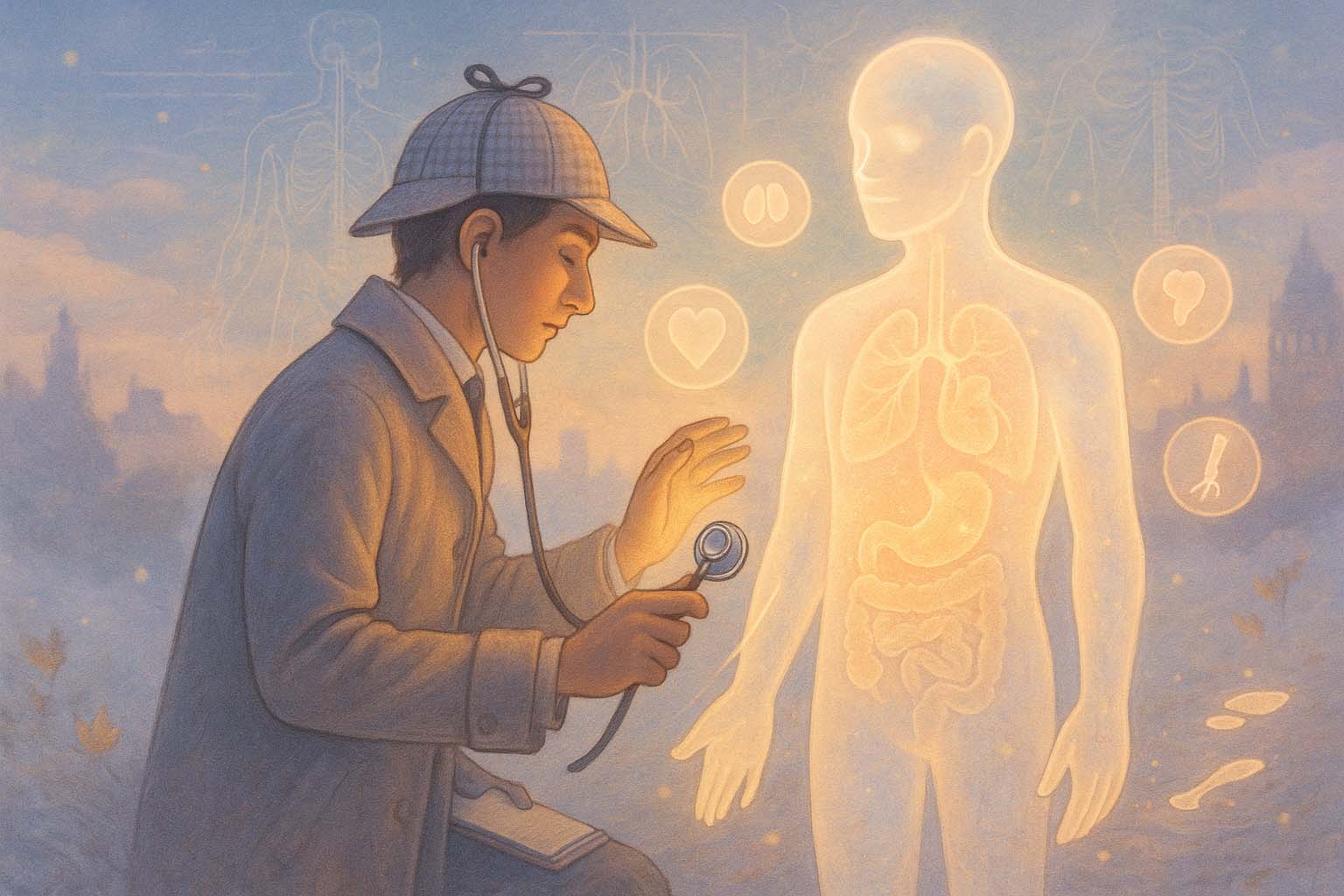
Physical Examination
- The Detective’s Toolkit
🔍 Mastering the Art of Physical Examination
Once the story has been told, it’s time to inspect the scene.
Welcome back to the field, detective. The history has given you the narrative—the timeline, the key characters, and the potential culprits. Now, with the physical examination, you step into the scene of the mystery itself. This is where observation meets touch, sound meets structure, and the truth sometimes reveals itself in the subtlest of signs.
In medicine, the physical examination is not a single act—it’s a sequence of skilled maneuvers, tailored to each body system, each symptom, and each suspicion. Your toolkit? Four timeless techniques: inspection, palpation, percussion, and auscultation—adapted to the terrain you explore.
👁️ Inspection: The Keen Observer’s Eye
As any seasoned investigator knows, the first step is to look.
Before your stethoscope even touches the patient, your eyes begin gathering data. You assess:
- General appearance: Are they comfortable or distressed? Pale or flushed? Sweating or shivering?
- Posture and gait: Do they guard one side of their body? Are they limping? Slouching?
- Visible signs: Rashes, scars, tremors, bruising, swelling, jaundice, or abnormal movements?
A patient with finger clubbing and a chronic cough? You suspect lung disease. A butterfly rash across the cheeks? You consider lupus. A sharp-eyed detective never underestimates the power of first impressions.
✋ Palpation: The Investigator’s Touch
Touch gives you insight where sight cannot.
Through gentle pressure and purposeful probing, you gather information about:
- Tenderness: Is that upper right abdominal pain indicative of gallbladder inflammation?
- Masses: Can you feel a thyroid nodule? An enlarged spleen? A suspicious lump?
- Temperature or texture changes: Is the leg warm and swollen, suggesting DVT? Is the skin dry and coarse as in hypothyroidism?
In a cardiovascular exam, palpating the apex beat can hint at heart enlargement. In the abdomen, you check for guarding, rigidity, and rebound tenderness—clues that might indicate peritonitis. The hands of a good clinician, like those of a careful detective, are steady, respectful, and always alert to anomalies.
🥁 Percussion: Tapping for Hidden Clues
Percussion is the art of tapping for truth.
Just as a detective might knock on a hollow wall to find a hidden compartment, you use your fingers to assess what lies beneath the surface. The sound changes depending on what’s underneath—air, fluid, or solid tissue:
- Dullness where there should be resonance? Suspect a pleural effusion or liver enlargement.
- Hyper-resonance? Consider pneumothorax or chronic obstructive pulmonary disease (COPD).
- Shifting dullness or fluid thrill in the abdomen? You’re thinking ascites.
Percussion turns invisible signs into audible ones, converting sound into suspicion and suspicion into targeted hypotheses.
🎧 Auscultation: Listening to the Body’s Secrets
Finally, you listen.
Using your stethoscope—the detective’s wiretap into the body—you tune into the internal whispers of:
- Heart murmurs: Could this be aortic stenosis, or mitral regurgitation?
- Lung sounds: Are those crackles the hallmark of pneumonia? Are wheezes narrowing your focus to asthma?
- Bowel sounds: High-pitched tinkles may suggest obstruction; silence may speak of ileus.
In each case, auscultation offers crucial, sometimes decisive, evidence. It’s how you confirm your suspicions—or, like any good investigator, revise your theory based on new intel.
🧭 Different Systems, Different Clues
The detective’s toolkit is versatile—but how you use it depends on the system you’re examining. Here are a few snapshots from the field:
🫀 Cardiovascular
- Inspection: Cyanosis? Clubbing?
- Palpation: Peripheral pulses? Thrills?
- Auscultation: Murmurs? Rubs? Extra heart sounds?
🫁 Respiratory
- Inspection: Use of accessory muscles? Chest wall movement?
- Percussion: Dullness in consolidation, hyper-resonance in pneumothorax.
- Auscultation: Crackles, wheezes, bronchial breathing?
🧠 Neurological
- Inspection: Facial asymmetry? Involuntary movements?
- Palpation: Muscle tone and strength?
- Special tests: Reflexes, cranial nerve function, coordination.
🧫 Gastrointestinal
- Inspection: Scars, distension, peristalsis?
- Palpation: Masses, tenderness, organomegaly?
- Auscultation: Bowel activity?
Each system has its own landscape, and the skilled clinician adapts their approach accordingly. Like a detective with multiple cases, you must know when to zoom in, when to step back, and when to cross-reference clues from different scenes.
🧩 Putting the Pieces Together
The physical examination is not separate from the story—it’s an extension of it.
Sometimes, the findings corroborate the history perfectly. Other times, they throw your theory into disarray—and that’s where the real detective work begins. A murmur that contradicts a benign history. A rigid abdomen in a patient who “just has gas.” A neurological deficit in a fall that “seemed minor.”
Each sign is a lead. Each finding is a thread. Your job is to pull gently, patiently, and see where the weave unravels.
🕯️ Final Word from Medlock
Remember, Holmes didn’t solve mysteries with gadgets—he solved them with observation. The same is true for you.
A good physical examination is not a rushed ritual. It is a deliberate, respectful, hands-on inquiry into the truth of the human body. With every exam, you hone your instincts, sharpen your senses, and bring your medical reasoning to life.
Stay curious. Stay observant. And never underestimate the secrets that skin, breath, and heartbeat are waiting to tell.
